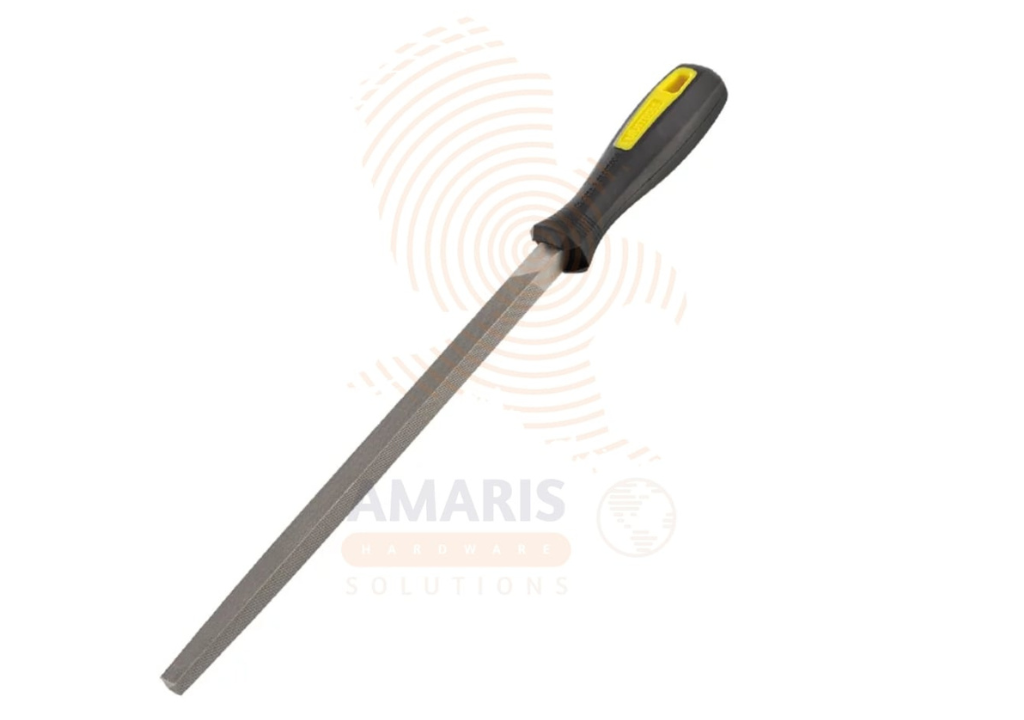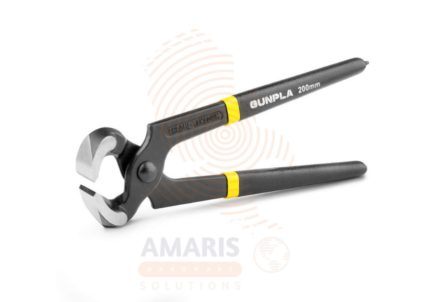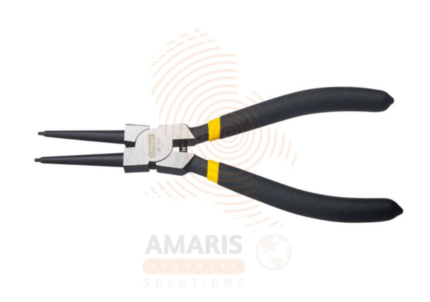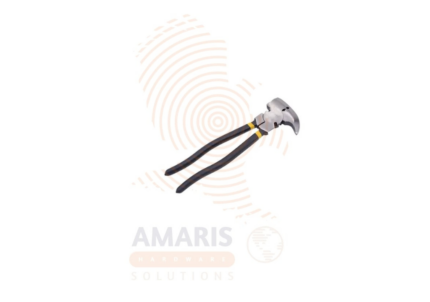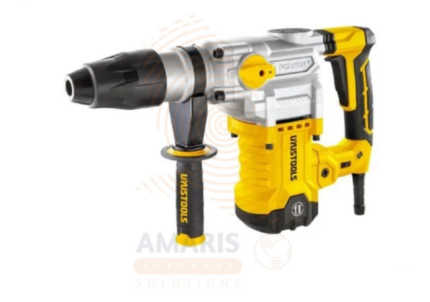
Rotary Hammer Variable Speed
$95.77 Original price was: $95.77.$90.98Current price is: $90.98.
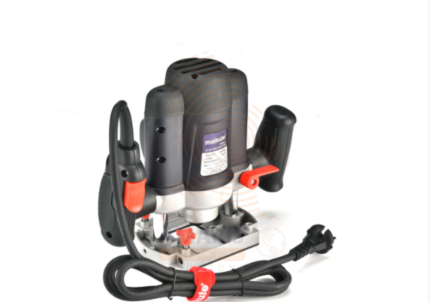
Router
$65.00 Original price was: $65.00.$61.75Current price is: $61.75.
Round Hand File
$14.73 Original price was: $14.73.$13.99Current price is: $13.99.
WhatsApp Order
A round hand file is a type of hand tool used for shaping and smoothing metal, wood, or other materials. It typically consists of a hardened steel rod with a cylindrical cross-section and teeth or cutting edges along its length. The round shape allows for versatile use in shaping concave surfaces, enlarging holes, and removing material in curved or circular patterns. Hand files, including round hand files, are commonly employed in various industries such as metalworking, woodworking, and crafting, providing a manual and precise means of material removal and surface finishing.
Category: HAND TOOLS
Tags: curved surface file, hand file, manual file, metal shaping tool, precision filing, round file, woodworking file
Description
Table of Contents
ToggleRound Hand File
Uses
-
Shaping and Smoothing Curves: Round hand files are ideal for shaping and smoothing curved or rounded surfaces. They are often used to refine contours on metal or woodwork.
-
Enlarging Holes: The cylindrical shape of the round file makes it suitable for enlarging holes in metal or wood. This is particularly useful when precision is required, such as fitting bolts or screws.
-
Deburring: After cutting or machining processes, sharp edges and burrs may be left on the workpiece. Round hand files can be used to remove these burrs and create smooth edges.
-
Filing Inside Cylindrical Surfaces: The round shape of the file allows it to be used effectively in cylindrical or concave surfaces, such as the inside of pipes or rounded metal components.
-
Tool Sharpening: Round files are often used for sharpening certain tools, such as chainsaw teeth. They can help maintain the cutting edge of tools that have a curved or cylindrical profile.
-
Craftsmanship and Jewelry Making: In crafts and jewelry making, round hand files are employed to shape and refine intricate details in metalwork. They are essential for achieving precision and fine finishes.
-
Model Making: Round files are useful in model making, where precision and attention to detail are critical. They can be used to shape and smooth various materials used in model construction.
-
Keyway and Groove Cutting: When working with machinery, round files can be used for cutting keyways or grooves in metal components to facilitate the fitting of keys, pins, or other mechanical parts.
-
Instrument Making: In the creation of musical instruments or other precision instruments, round files are used to shape and refine components, ensuring a high level of accuracy.
-
General Material Removal: Round hand files can be used for general material removal when precision shaping or smoothing is required on various materials, including metals, plastics, and wood.
SAFETY HANDLING PRECAUTIONS
Safety Precautions
-
Wear Personal Protective Equipment (PPE):
-
Safety Glasses: Protect your eyes from flying debris, especially when filing metal or other hard materials.
-
Gloves: Wear appropriate gloves to protect your hands from sharp edges, burrs, and potential injuries.
-
-
Secure the Workpiece:
-
Ensure that the workpiece is securely clamped or held in place. This prevents unexpected movement that could lead to accidents or injuries.
-
-
Proper Gripping Technique:
-
Hold the file with a firm grip, and position your hands away from the cutting edges to avoid accidental contact.
-
-
Work in a Well-Lit Area:
-
Adequate lighting ensures that you can see the workpiece and the file clearly, reducing the risk of errors and accidents.
-
-
Inspect the File:
-
Before use, inspect the file for any damage, such as chips or cracks. A damaged file may not perform properly and could pose a safety risk.
-
-
Use the Right File for the Job:
-
Ensure that you are using the correct type and size of round hand file for the specific task. Using the wrong file can be less effective and may increase the risk of accidents.
-
-
File Away from the Body:
-
When filing, direct the tool away from your body to minimize the risk of injury if the file slips or if there is unexpected resistance.
-
-
Avoid Overexertion:
-
Let the file do the work; excessive force may lead to loss of control and potential accidents. Use a steady, controlled motion.
-
-
Keep the File Clean:
-
Regularly clean the file to remove accumulated material (swarf). This helps maintain the effectiveness of the file and reduces the risk of slipping.
-
-
Mind Your Surroundings:
-
Be aware of your environment and the presence of others. Ensure there is enough space to maneuver and that bystanders are a safe distance away.
-
-
Follow Proper Technique:
-
Learn and use proper filing techniques. Misuse or improper handling of the file can lead to accidents or suboptimal results.
-
-
Store Files Properly:
-
When not in use, store files in a safe and organized manner to prevent damage and to ensure that they are not a hazard to yourself or others.
-
Related products
Bi-Metal Hole Saw Set
A 9 PCS Bi-Metal Hole Saw Set refers to a collection of nine hole saws, each constructed with a bi-metal design. A hole saw is a cylindrical cutting tool used to create holes in various materials such as wood, metal, plastic, and more. The term "bi-metal" indicates that the hole saws are made from two different types of metals, typically high-speed steel (HSS) and a more durable alloy like cobalt. This combination enhances the hole saw's cutting performance, making it suitable for a wide range of applications and providing increased durability and longevity. The set typically includes hole saws of different sizes to accommodate various hole diameters, making it a versatile tool for professionals and DIY enthusiasts alike.
Carpenter’s Pincers
Carpenter's pincers, also known as end-cutting pliers or end nippers, are a type of hand tool used in carpentry and woodworking. They typically have sharp, pointed jaws that come together in a cutting edge at the tips. These pincers are designed for gripping, cutting, and pulling materials such as nails, wires, or small objects in woodworking applications. The jaws are angled to provide leverage and facilitate precise cutting or gripping in tight spaces. Carpenter's pincers are a versatile tool commonly found in a carpenter's toolkit for various tasks related to shaping and assembling wood.
Combination spanner set
A combination spanner set typically refers to a collection of twelve different-sized spanners that feature both open-end and box-end configurations. Combination spanners are versatile tools commonly used in mechanical and household applications. The open end is designed to grip fasteners in tight spaces, while the box end provides a more secure grip on the flats of a nut or bolt.
The set usually includes a range of sizes to accommodate various fastener dimensions. Each spanner in the set may be marked with its specific size, typically in metric or imperial units. This versatile tool set is essential for tasks that require tightening or loosening nuts and bolts in different applications, providing flexibility and convenience for the user.
Countersink Drill Set
A countersink drill set typically refers to a collection of six tools designed for countersinking operations in woodworking or metalworking. Each set usually includes six individual countersink drills with varying sizes or angles. Countersinking is a process that involves creating a conical hole in a material, allowing the head of a screw or bolt to sit flush with or below the surface. These drill sets are essential for achieving a professional finish in various applications where a smooth and even surface is desired, such as in carpentry, metal fabrication, or DIY projects.
Electronic Wire Stripper
PRODUCT DESCRIPTION
An electronic wire stripper is a specialized handheld tool designed for efficiently and accurately removing the insulation or outer covering from electrical wires. It incorporates motorized or automated mechanisms to cut through and strip the insulation without damaging the underlying conductive wire. This tool is commonly used in electrical and electronic applications to streamline the process of preparing wires for connection, ensuring precision and reducing the risk of damage to the wire during the stripping process.
External Circlip Pliers Straight
External circlip pliers – straight, also known simply as external circlip pliers or snap ring pliers, are specialized hand tools designed for installing and removing external circlips or snap rings. Circlips are ring-shaped fasteners with open ends that fit into machined grooves on the outside of a shaft or bore. External circlip pliers are specifically designed to work with these types of retaining rings.
The "straight" designation indicates that the tips of the pliers are aligned in a straight line, as opposed to angled or curved tips. This straight configuration allows for easier access to circlips in certain applications.
These pliers typically have pointed or semi-circular jaws that fit into the holes or notches of the circlip, facilitating the compression or expansion of the ring for installation or removal. The handles are designed for comfortable grip and effective leverage.
Fence Pliers
Fence pliers are a specialized type of pliers designed for use in fencing and related tasks. They typically feature a combination of functions that make them well-suited for various activities involved in installing, repairing, and maintaining fences. These pliers often include features such as a gripping jaw, wire-cutting blades, a staple puller, and sometimes a hammerhead. The design of fence pliers aims to provide versatility and convenience for professionals or DIY enthusiasts working with fencing materials, wires, and staples.
Flat Screwdriver
A flat screwdriver, also known as a slotted screwdriver, is a hand tool designed for turning screws with a slotted (flat) head. It typically features a flat, narrow, and straight metal blade, with a handle at one end for gripping and rotating the tool. The blade is inserted into the corresponding slot in the screw head, and by applying torque to the handle, the screwdriver allows for the tightening or loosening of the screw. Flat screwdrivers are commonly used in various manual and mechanical applications for tasks such as assembling furniture, fixing appliances, and general household repairs.


 Acrylic Sealants
Acrylic Sealants Construction Adhesives
Construction Adhesives Double-Sided Tape
Double-Sided Tape Duct Tape
Duct Tape Electrical Tape
Electrical Tape Epoxy & Resins
Epoxy & Resins Masking Tape
Masking Tape
 Automotive Wrenches & Socket Sets
Automotive Wrenches & Socket Sets Battery Chargers & Jump Starters
Battery Chargers & Jump Starters Car Jacks & Stands
Car Jacks & Stands Car Wash & Detailing Products
Car Wash & Detailing Products Diagnostic Tools
Diagnostic Tools Tire Inflators
Tire Inflators Vehicle Lighting
Vehicle Lighting Oil & Lubricants
Oil & Lubricants
 Adhesives & Sealants
Adhesives & Sealants Bricks & Blocks
Bricks & Blocks Cement & Concrete
Cement & Concrete Drywall & Plaster
Drywall & Plaster Flooring (Tiles, Wood, Laminate)
Flooring (Tiles, Wood, Laminate) Lumber & Plywood
Lumber & Plywood Paints, Primers & Coatings
Paints, Primers & Coatings Insulation Materials
Insulation Materials Roofing Materials
Roofing Materials
 Circuit Breakers
Circuit Breakers Electrical Cables & Wires
Electrical Cables & Wires Switches & Sockets
Switches & Sockets Fuses & Relays
Fuses & Relays Connectors & Terminals
Connectors & Terminals Electrical Boxes & Panels
Electrical Boxes & Panels Conduit & Fittings
Conduit & Fittings Lighting Fixtures & Bulbs
Lighting Fixtures & Bulbs Extension Cords & Power Strips
Extension Cords & Power Strips
 Anchors
Anchors Bolts
Bolts Clips & Clamps
Clips & Clamps Screws
Screws Nuts
Nuts Washers
Washers Rivets
Rivets Nails
Nails Threaded Rods
Threaded Rods
 Hammers
Hammers Measuring Tools (Tapes, Levels, Calipers)
Measuring Tools (Tapes, Levels, Calipers) Screwdrivers
Screwdrivers Pliers & Cutters
Pliers & Cutters Saws & Blades
Saws & Blades Chisels & Punches
Chisels & Punches Allen Keys & Hex Keys
Allen Keys & Hex Keys Ratchets & Socket Sets
Ratchets & Socket Sets Wrenches & Spanners
Wrenches & Spanners
 Power Tool Accessories (Blades, Bits, Discs)
Power Tool Accessories (Blades, Bits, Discs) Rotary Tools
Rotary Tools Saws (Circular, Jigsaw, Reciprocating)
Saws (Circular, Jigsaw, Reciprocating) Drills & Drivers
Drills & Drivers Grinders & Sanders
Grinders & Sanders Heat Guns
Heat Guns Nail Guns
Nail Guns Impact Wrenches
Impact Wrenches Batteries & Chargers
Batteries & Chargers
 Pipes & Fittings (PVC, Copper, PEX)
Pipes & Fittings (PVC, Copper, PEX) Plumbing Tools
Plumbing Tools Pumps & Motors
Pumps & Motors Sealants & Adhesives for Plumbing
Sealants & Adhesives for Plumbing Valves & Taps
Valves & Taps Water Heaters
Water Heaters Drainage Systems
Drainage Systems Faucets & Fixtures
Faucets & Fixtures Hoses & Tubing
Hoses & Tubing
 Hinges & Latches
Hinges & Latches Hooks & Brackets
Hooks & Brackets Window Hardware
Window Hardware Chains & Cables
Chains & Cables Casters & Wheels
Casters & Wheels Shelving & Storage Systems
Shelving & Storage Systems Door Handles & Locks
Door Handles & Locks Drawer Slides & Cabinet Hardware
Drawer Slides & Cabinet Hardware
 Personal Protective Equipment (PPE)
Personal Protective Equipment (PPE) Respirators & Masks
Respirators & Masks Safety Glasses
Safety Glasses Safes
Safes Security Cameras
Security Cameras Gloves
Gloves Helmets
Helmets Ear Protection
Ear Protection Fire Safety Equipment
Fire Safety Equipment Locks & Padlocks
Locks & Padlocks Motion Sensors & Alarms
Motion Sensors & Alarms
 Garden Fencing
Garden Fencing Garden Furniture Hardware
Garden Furniture Hardware Lawn Mowers
Lawn Mowers Trimmers & Edgers
Trimmers & Edgers Shovels & Spades
Shovels & Spades Rakes & Hoes
Rakes & Hoes Pruning Shears & Loppers
Pruning Shears & Loppers Watering Systems (Hoses, Sprinklers, Nozzles)
Watering Systems (Hoses, Sprinklers, Nozzles)
 Interior Paints
Interior Paints Paint Brushes & Rollers
Paint Brushes & Rollers Paint Strippers & Thinners
Paint Strippers & Thinners Paint Trays & Accessories
Paint Trays & Accessories Exterior Paints
Exterior Paints Spray Paints
Spray Paints Primers & Undercoats
Primers & Undercoats Varnishes & Stains
Varnishes & Stains
 Gaskets & Seals
Gaskets & Seals Hydraulic Fittings
Hydraulic Fittings Industrial Fasteners
Industrial Fasteners Industrial Hoses
Industrial Hoses Lubricants & Greases
Lubricants & Greases Metal Sheets & Bars
Metal Sheets & Bars Bearings & Bushings
Bearings & Bushings Belts & Pulleys
Belts & Pulleys
 HVAC Filters
HVAC Filters Insulation for HVAC
Insulation for HVAC Air Conditioners
Air Conditioners Refrigerants
Refrigerants Ventilation Ducts & Fittings
Ventilation Ducts & Fittings Thermostats & Controllers
Thermostats & Controllers Fans & Blowers
Fans & Blowers
 Pegboards & Hooks
Pegboards & Hooks Shelving Units
Shelving Units Storage Bins & Containers
Storage Bins & Containers Toolboxes & Tool Chests
Toolboxes & Tool Chests Workbenches
Workbenches Drawer Organizers
Drawer Organizers Labeling Supplies
Labeling Supplies
 Welding Accessories (Clamps, Brushes)
Welding Accessories (Clamps, Brushes) Welding Electrodes & Rods
Welding Electrodes & Rods Welding Helmets & Gloves
Welding Helmets & Gloves Welding Machines
Welding Machines Soldering Irons & Stations
Soldering Irons & Stations Flux & Solder Wire
Flux & Solder Wire
 Generator Accessories
Generator Accessories Inverters
Inverters Portable Generators
Portable Generators Power Inverters
Power Inverters Transfer Switches
Transfer Switches Diesel & Gasoline Generators
Diesel & Gasoline Generators
 Transport Equipment: Carts, Dollies, and Hand Trucks
Transport Equipment: Carts, Dollies, and Hand Trucks Storage Solutions: Pallets, Racks, and Containers
Storage Solutions: Pallets, Racks, and Containers Lifting Equipment: Hoists, Cranes, and Jacks
Lifting Equipment: Hoists, Cranes, and Jacks Conveyors and Accessories: Belts and Rollers
Conveyors and Accessories: Belts and Rollers